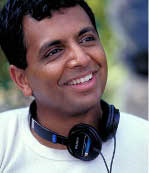
Questions are Raised about some of Shyamalan's Films
September 10th, 2004
Writer-director M. Night Shyamalan’s the “The Village” and the award-winning children's novel “Running Out of Time” have striking similarities according to Josh Grossberg of E! Online in a report earlier last month.

“Running Out of Time” has sold more than a half-million copies since it was published in 1995. It could possibly have come to the attention of Shyamalan, whose movie mirrors the book in several key areas including the central character, the setting, the application of the time period in which they're set, and the secret that provides “The Village” with its surprise ending.
Margaret Peterson Haddix, the author of “Running Out of Time,” said she saw the film and reportedly acknowledged that she also found “some similarities,” but did not go on to elaborate.
“It was the fans that really pointed it out in the first place,” says van Straaten a spokeswoman for the book’s publisher. “The book is about a young tomboyish girl in a rural village in the 1800s who comes to learn that, in fact, it is a historical preserve in 1996 and that the adults have kept that secret from the children of the village. She finds that out when her mother sends her out to get medicine. But she learns it pretty early on in the book and then discovers all sorts of other intrigue.”
The movie takes place in 1897 where adults keep a secret from the children. In the movie the town's isolation is strictly enforced to maintain the secret. And in both the film and the novel, a young woman is sent out into the world to bring back medicines that the villagers desperately need.
A spokesman for the Walt Disney Company, which released the film in late July, told the Mercury News that studio officials spoke to Shyamalan’s representatives and that there is “…absolutely no connection'” between the movie and the book.
Interestingly enough, this may not be the only case of Shyamalan lifting story ideas from others. Last year Pennsylvania screenwriter Robert McIlhinney filed a claim that accuses the filmmaker of ripping off his script for the filmmaker's last movie, “Signs.” McIlhinney claims his unproduced script “Lord of the Barrens: The Jersey Devil” has similar elements. No details were given on how Shyamalan would have managed to get ahold of McIlhinney's script.
But if you think about it, Shyamalan would have some reasons for not giving credit to possible sources for his inspiration. “The Village” has grossed over $112 million thus far. On top of that, Disney gave him $5 million for “Signs,” as he listed himself as the sole screenwriter. That deal made him the highest-paid screenwriter in Hollywood at the time.
(Source: http://www.eonline.com/News/Items/0,1,14684,00.html)
Only logged-in members can comment. You can log in or join today for free!
Advertisement






